Environmental Demand node
Introduction
The Environmental Demand Model (EDM) provides a way of simulating environmental water (flows) requirements in Source, effectively by generating 'environmental demands' in a manner analogous to other water user demands in Source.
Environmental water (flows) requirements are represented in the EDM as ‘flow rules’. A flow rule will predict the water required to achieve predefined environmental flow objectives/requirements. These requirements may be directed at in-channel and/or floodplain habitats and ecosystems.
In Source, Environmental Demand (ED) is modelled using the environmental demand node. Refer to Environmental Demand for further details. The node can be configured to fulfill either in-stream or floodplain requirements.
It is important to note the two different ways in which an ED node can be set up. These are:
- EDM on main river channel link - Typically used to specify flows relating to the provision of in-stream requirements, such as providing: suitable water depths (eg. for fish passage); wetted habitat (eg. for fish breeding); connectivity (eg. connecting drought refuges); or to meet in-stream water quality targets (eg. for dilution flows). The ED node will allow almost all such requirements to be configured in Source.
In addition, an in-stream requirement ED node can also be set up to order water that ultimately moves from the river channel to the floodplain via an anabranch, distributary or flood-runner (for example, at 90% bank-full). For Australian users, this is the way in which environmental water requirements for floodplain ecosystems are often specified ie. according to flow requirements for the main river channel, that are based on known hydrologic linkages with the floodplain (eg. X ML/d for Y days duration to ensure inundation of floodplain wetland Z); and - EDM on floodplain branch link: Better represents the actual environmental demand of a floodplain ecological asset. Different to the above example, in which an in-stream flow requirement (eg. X ML/d for Y days duration to ensure inundation of floodplain wetland Z) is effectively a surrogate for the actual floodplain environmental demand.
An environmental demand node configured on a floodplain branch (below a splitter) orders water according to the hydrologic characteristics of that branch - by specifying a flow rate at a point in the branch - with the splitter specifying the hydrologic relationship with the main channel (via a ratings table or curve).
Note: Although it is essential to understand the two distinctions, it is possible to fulfill many in-stream and floodplain requirements in the same model by changing the configuration of the node.
Using the node in Source
Double-click the node to open its feature editor, shown in Figure 1. If you have an account configured (using the Resource Assessment Explorer), you will be able to enable or disable Account Distribution using the contextual menu shown.
You can select whether the EDM is inclusive or exclusive of downstream orders. If inclusive (default value), then the order generated by the EDM will be the difference between the EDM’s water order and the downstream order. In this case, the Inclusive of Downstream Orders slider is selected to YES. This assumes that the EDM can take advantage of the required water downstream to meet all or part of its requirements. If the EDM is exclusive of the downstream order, the EDM’s water will be added to the downstream order - the slider is selected to NO.
Figure 1. Environmental Demand node
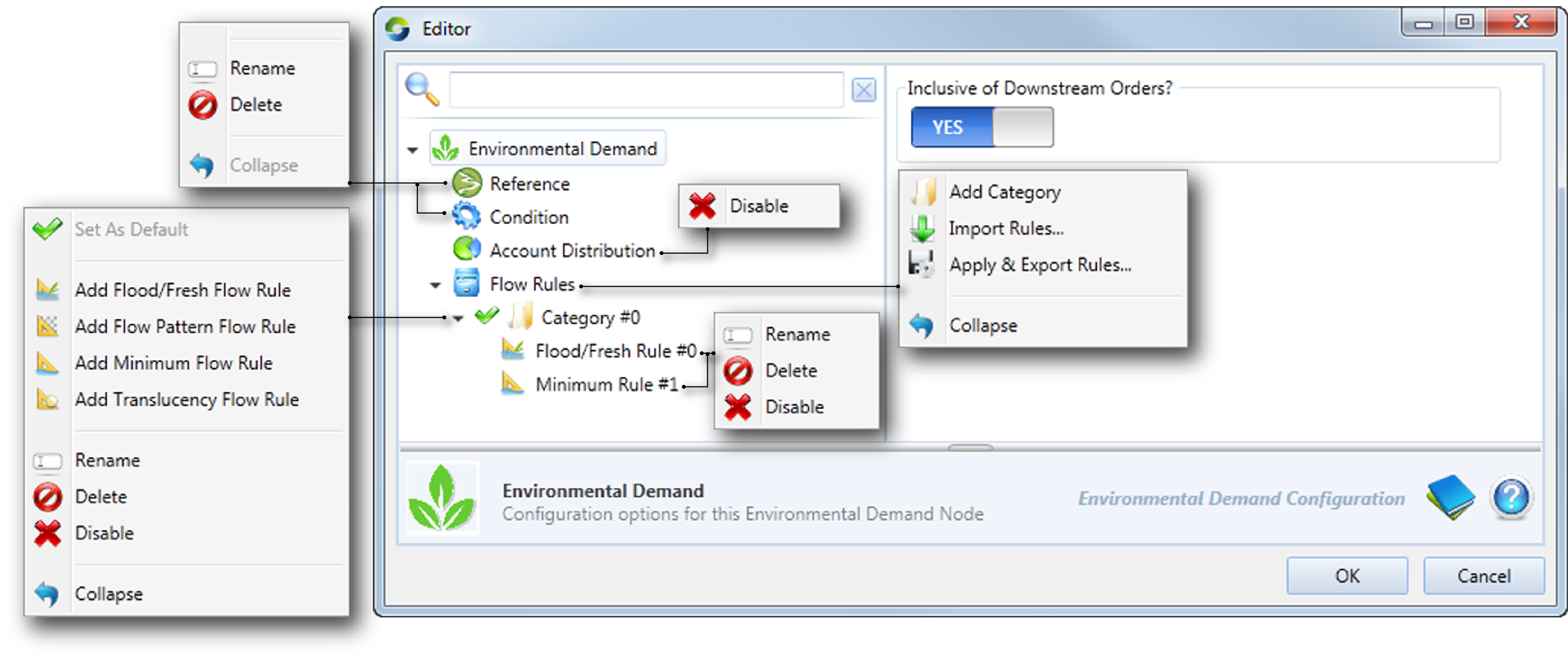
Flow rules
The four types of flow rules presented in the EDM have been designed to capture the most commonly defined environmental flow requirements specified in environmental flow studies and water regulations. These four types of environmental demand rules allow users to construct a collective environmental water requirement by using combinations of environmental demand rules. The four rule types are:
- Minimum flow - specifies a minimum flow, usually applied to maintain minimum habitat or dilution flow requirements;
- Flood/Fresh - specifies a flood fresh, usually associated with a recruitment event such as to trigger fish movement, water floodplain vegetation;
- Translucency - specifies the flow requirements in terms of some other time series, usually the release from a dam based on the inflow of the dam; and
- Flow pattern - specifies a pattern of flow, used to define multi-peak events.
Common elements of each of the four rule types that need to be configured are:
- Season - the period of the year over which the rule should be considered (eg a winter flooding rule only);
- Reporting interval - what is the acceptable number of years between applying the flow rule (eg high flows are only required once in 5 years);
- Augmentation Options - the preference for achieving the watering requirement. There are three augmentation options:
- Natural flow or matching a reference time series - usually uses a modelled scenario without development, and water demand for each rule will match the successful meeting of the rule that would occur under the reference flow;
- Extend - if a flow rule has started to be met, then water is ordered to extend the watering (eg tributary inflows have commenced a flood, and releases from the main channel dam may be used to extend the duration of the event); and
- Force - if by the end of the reporting interval, the flow rule has not been met, then a release will be ordered. This is similar to waiting until the last possible moment to meet the water requirements in the anticipation that the water requirements will be met by tributary flows or spills.
- When to use - each flow rule can have a ‘trigger’ specified, whereby for each day of the record, the trigger is checked against some relevant time series (such as storage volume) in order to set the flow rule to be on. This allows switching between rules at runtime to reflect watering options during dry vs wet periods.
You can import and export flow rules using the relevant contextual menu items (as shown in Figure 1).
Each rule also consists of a condition tracker, which is used to turn rules on and off. If the condition tracker falls bellow a threshold, the rule is turned on. If the condition tracker is above a threshold, then the rule is turned off. Only one condition tracker can be defined for a collection of rules. However, each individual rule can have its own threshold that decides when the rule is turned on. The condition tracker can be used to represent a multitude of environmental or accounting rules that turn flow rules on and off. Examples of using the condition tracker are:
- Representing the ‘health’ of an environmental asset; or
- Representing environmental rules that turn on and off when an account balance exceeds a certain level.
Rules can also be grouped using the Category hierarchical item.
Flood/fresh
The most common type of flow requirement is a flood/fresh which defines a flow requirement above a set level. Figure 2 shows the parameters for defining this requirement.
Figure 2. Environmental Demand node, Flood fresh
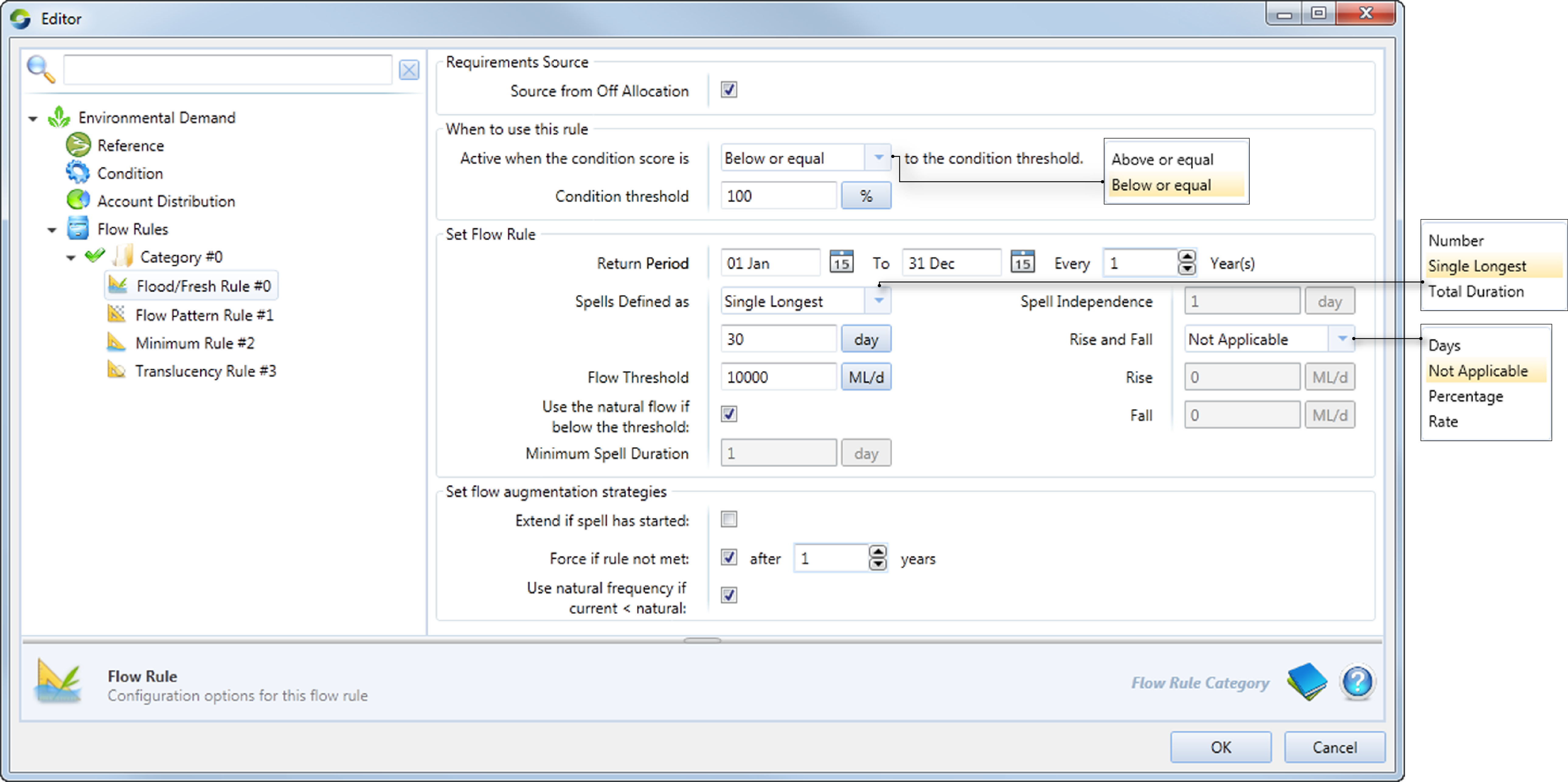
Flow pattern
You can create a temporally varying rule by simply defining the pattern of the flow required as well as a trigger condition. The trigger condition will be either a set start day or a flow threshold which has to be reached.
Figure 3. Environmental demand node, Flow pattern
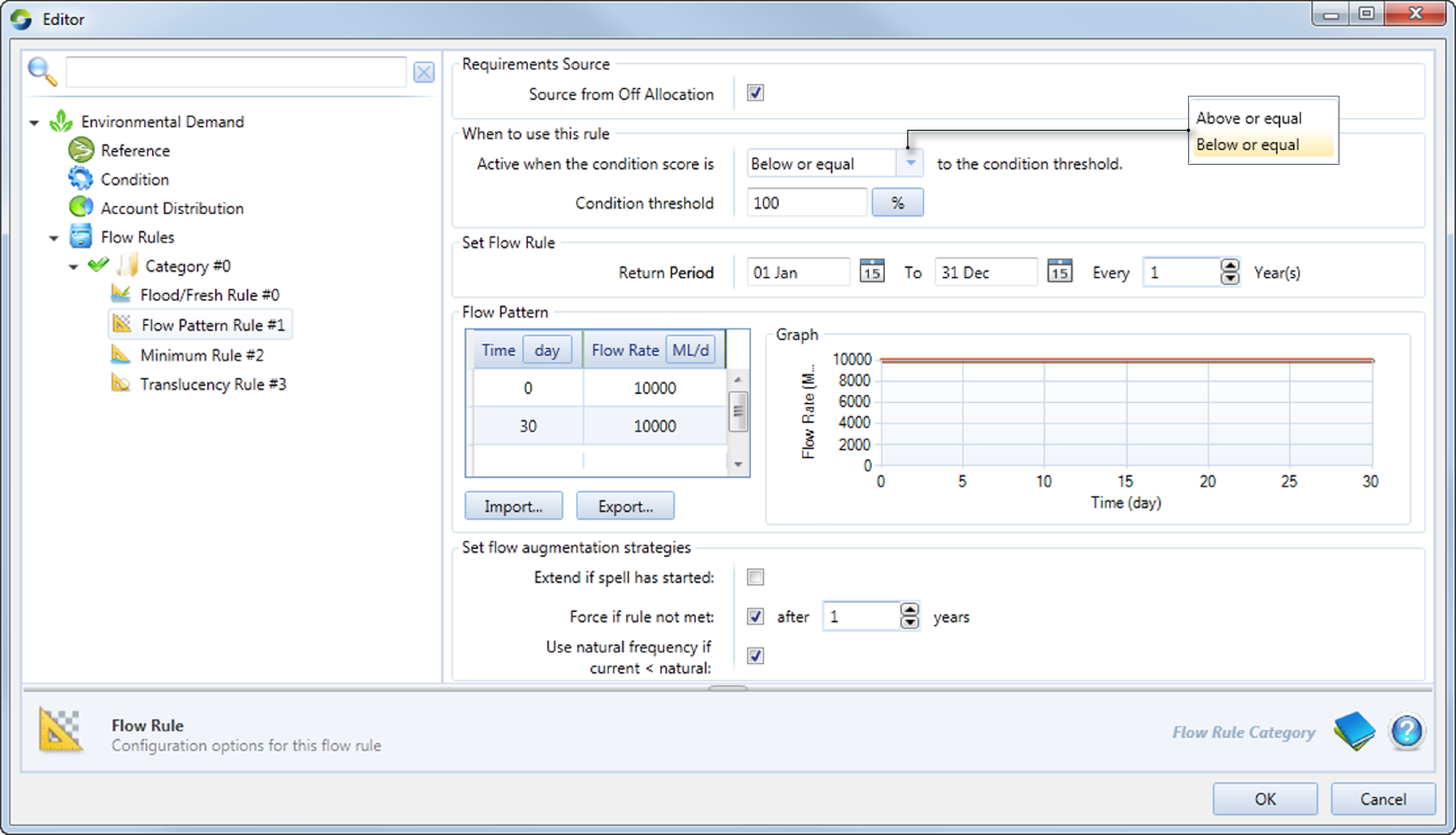
Minimum flow rule
The objective of this rule is to maintain a minimum flow in the model to maintain minimum habitat requirements, such as where flow should be kept above a certain limit for particular periods of the year. Figure 5 shows the parameters that must be specified for minimum flow.
Figure 4. Environmental demand node, Minimum rule
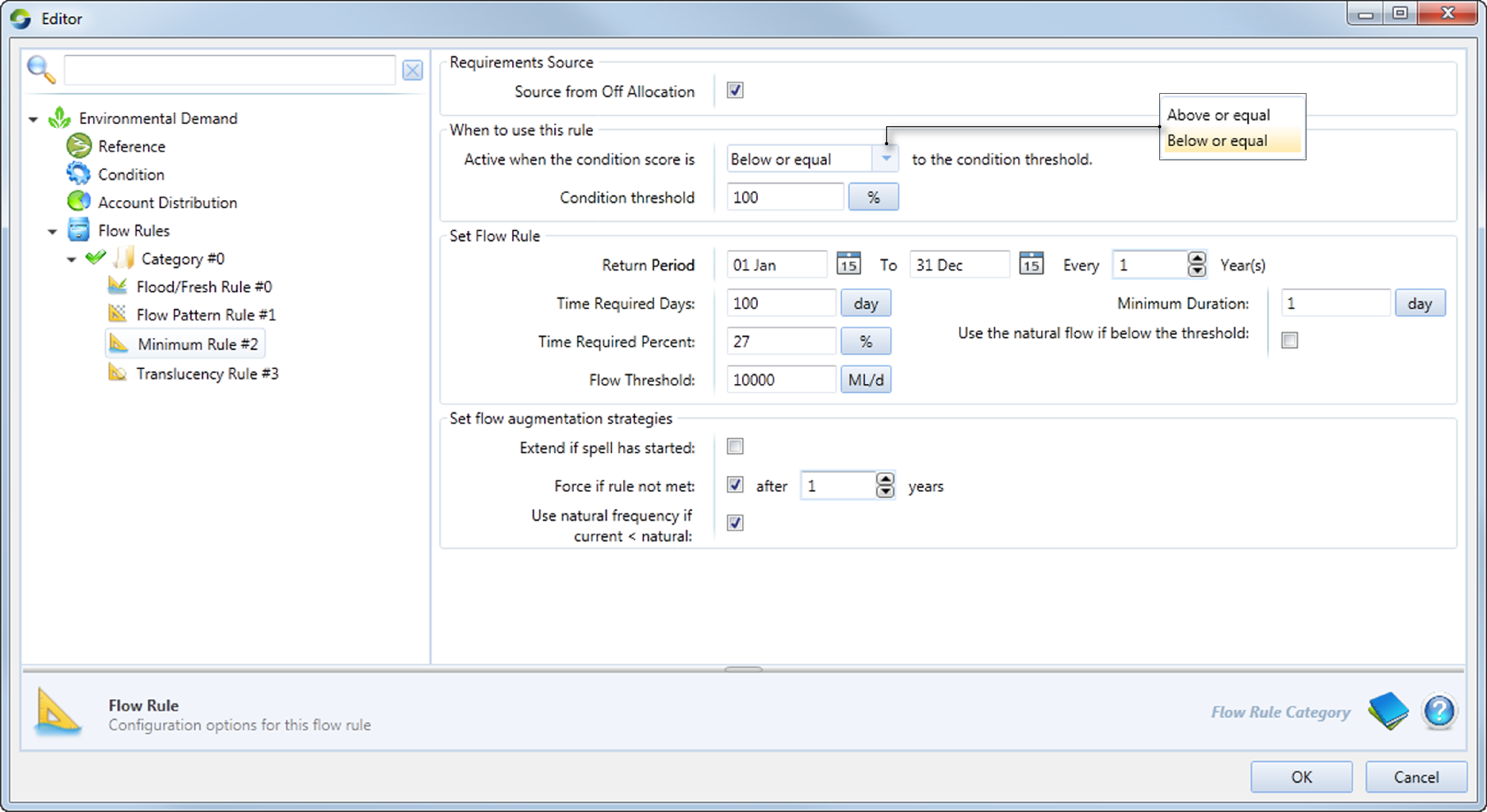
Translucency
This rule allows you to define conditions where flow would be allowed to pass through a storage or restrictions be placed on extraction in an unregulated system. It does not require an augmentation method as orders will be determined based on the inflows to the storage for the current time-step, and hence no forecasting is required.
Figure 5. Environmental demand node, Translucency
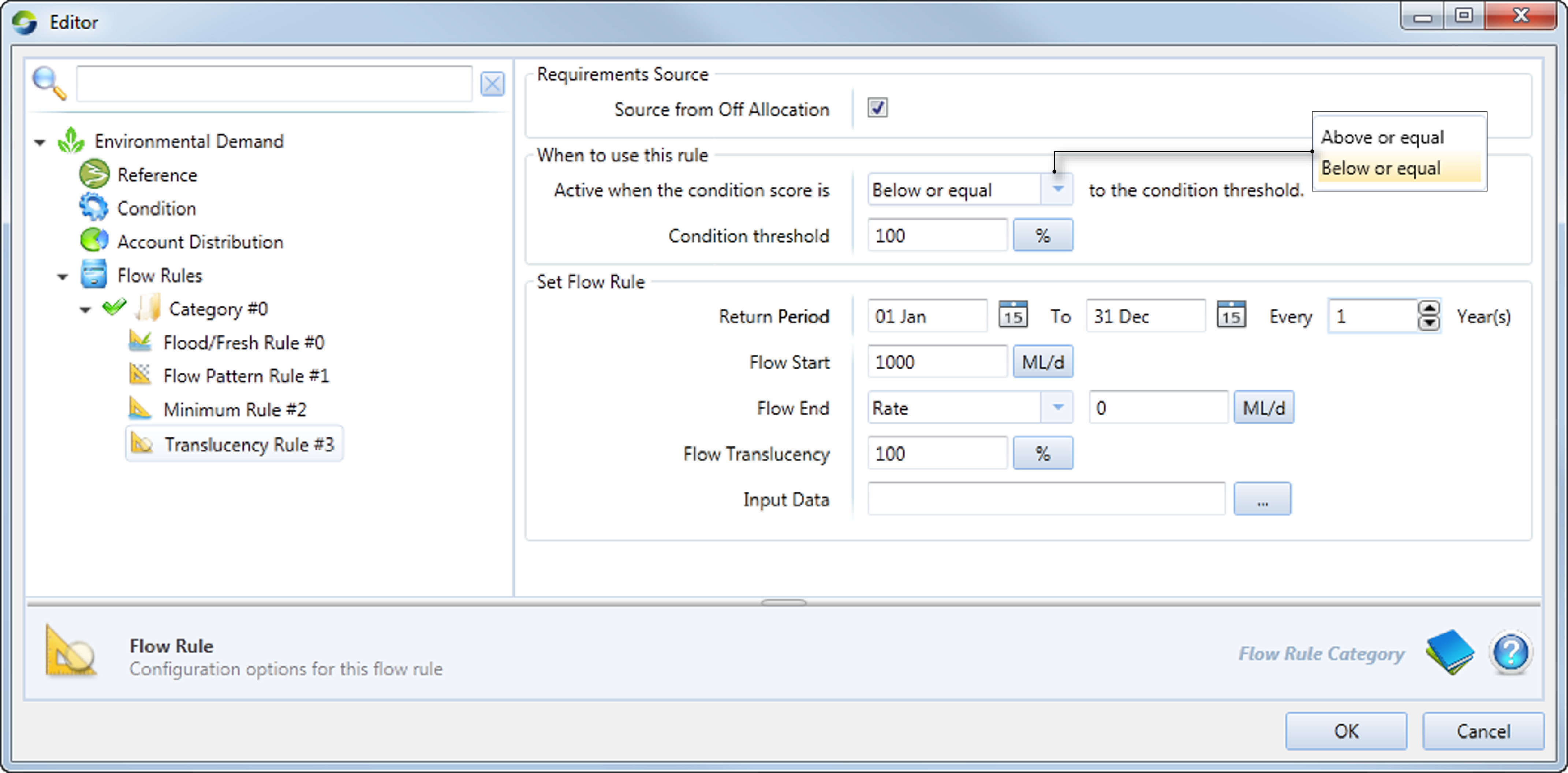
Grouping and prioritising
Flow rules can be grouped into categories. The default category is selected using the contextual menu.
Rule dependency
You can specify whether one flow rule will depend on another using the Add Rule Dependency button in the Flow Rules hierarchical item list. Figure 6, for example, shows that Flow Pattern Rule #1 will only come into effect when Minimum Rule #2's condition has been met.
Figure 6. Environmental demand node, Rule dependency
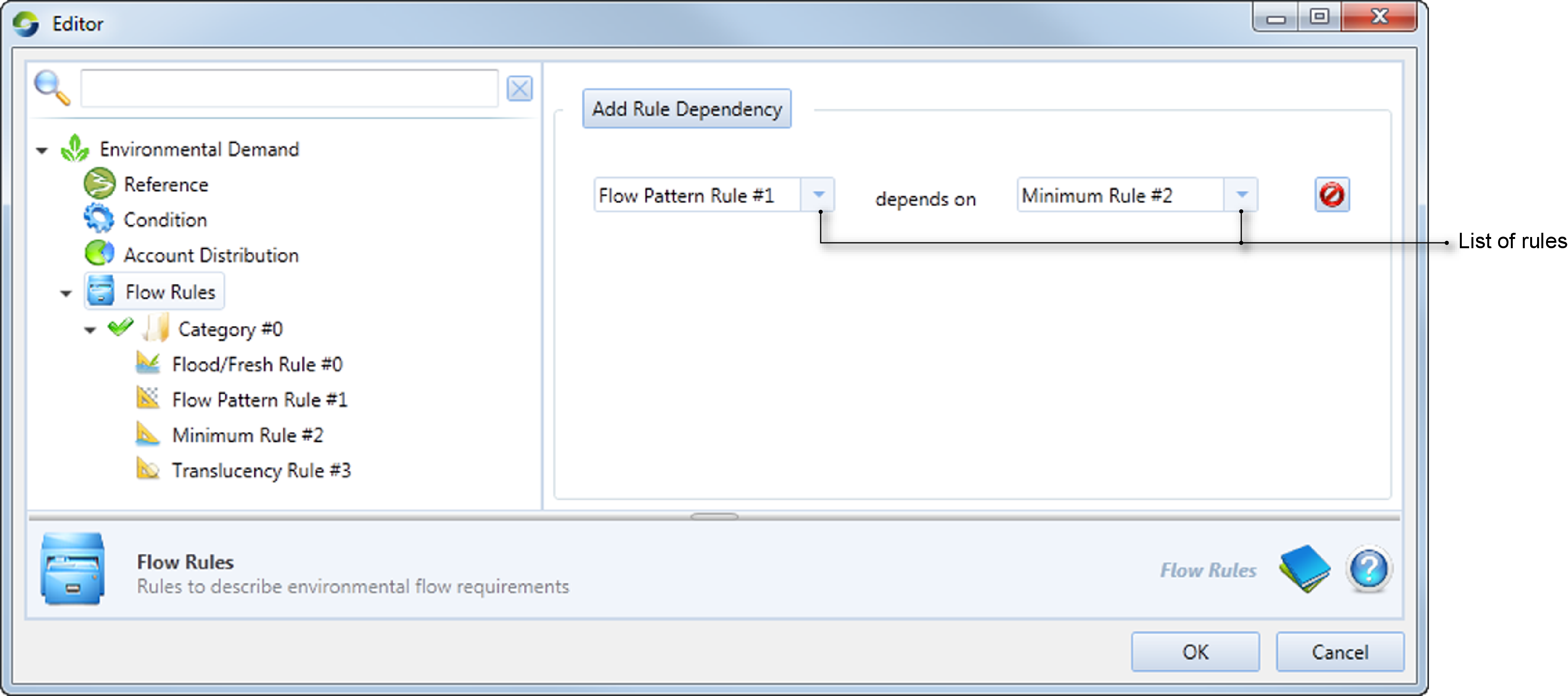
Condition
Flow rules can be made active or inactive dynamically during a modelling run. In order to control rules throughout the model run, each rule can have a defined condition threshold. This condition threshold is compared to the ‘condition’ time series for each time-step and the flow rule is turned on or off for that time-step as required. This functionality is specifically designed to allow the construction of asset based rule sets that vary according to water availability.
